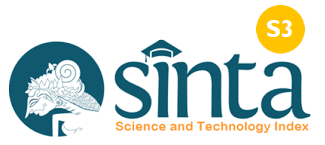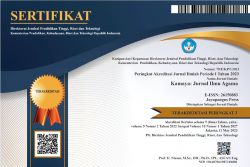Keterjalinan Jampé, Jangjawokan, dan TOGA dalam Naskah Mantra Pengobatan: Peran dan Fungsinya di Masyarakat Adat
DOI:
https://doi.org/10.37329/kamaya.v8i1.3916Keywords:
Jampé, Jangjawokan, Toga, Medicine Mantra Manuscripts, Role and Function in Indigenous PeoplesAbstract
A Sundanese manuscript, created by the ancestors' inventiveness, is a cultural document containing local wisdom. The Medical Mantra Manuscript is one of them. It reveals the truths of numerous TOGA as well as the presence of mantras in an effort to overcome and cure various diseases in society. Sundanese Mantra is classified into the following categories: ajian, asihan, jampé, jangjawokan, pélét, rajah, and singlar. This research, however, solely looks at the interweaving of the texts of the Mantra Jampé and Jangjawokan with TOGA, whose duties and functions are still practiced by indigenous peoples in West Java and indigenous Baduy people in Banten. The descriptive analysis research method was used. Involve philological study methods, both codicological and textological, literary studies, and cultural studies, so that the results are helpful and serve as a literacy reference for other disciplines. The utilization of plant species, functions, dosages, methods of processing, and treatments done accompanied by the recital of'mantras' in the text of the Medicinal Manuscripts demonstrates the relationship between Jampé and Jangjawokan and TOGA. The findings of this study are expected to be valuable not only for literature and philology, but also for public health, pharmacy, nursing, medicine, communication science, literature, anthropology, and culture in general.
References
Darsa, U. A. (1998). Khazanah Pernaskahan Sunda. Bandung: Fakultas Sastra Unpad.
Ekadjati, E. S. (1983). Naskah Sunda: Inventarisasi dan Pencatatan. Bandung: Kerjasama Lembaga Kebudayaan Universitas Padjadjaran dengan The Toyota Foundation (Laporan Penelitian).
Ekadjati, E. S., & Darsa, U. A. (1999). Katalog Induk Naskah-Naskah Nusantara Jilid 5A Jawa Barat Koleksi Lima Lembaga.
Heriyanto, L., Manggong, L., & Elis Suryani, N. S. (2019). Baduy Cultural Tourism: An Ethnolinguistic Perspective. International Journal of English Literature and Social Sciences (IJELS), 4(2), Maret–April.
Heriyanto, L., Manggong, L., & Elis Suryani, N. S. (2019). Language, Identity, and Cultural Tourism: An Ethnolinguistic Case-Study of Kampung Naga, Tasikmalaya, Indonesia. American Journal of Humanities and Social Sciences Research (AJHSSR), 3(3).
Kumala Sari, L. O. R. (2006). Pemanfaatan Obat Tradisional dengan Pertimbangan Manfaat dan Keamanannya. Majalah Ilmu Kefarmasian, 3(1), 1–7.
Rusyana, Y. (1970). Bagbagan Puisi Mantra Sunda. Bandung: Proyek Penelitian Pantun dan Folklore Sunda.
Sumarlina, E. S. N., dkk. (2011). Rahasia Pengobatan yang Terungkap dalam Naskah Mantra Sunda. Pengobatan Tradisional dalam Naskah Nusantara. Jurnal Manuskrip Nusantara (Jumantara). Jakarta: Perpustakaan Nasional Republik Indonesia.
Sumarlina, E. S. N. (2012c). Mantra Sunda dalam Tradisi Naskah Lama: Antara Konvensi dan Inovasi (Disertasi). Bandung: Program Pascasarjana Universitas Padjadjaran.
Sumarlina, E. S. N. (2013). Mantra Sunda: Keterjalinan Tradisi, Konvensi, dan Inovasi. Bandung: Sastra Unpad Press.
Sumarlina, E. S. N. (2017). Mantra dan Pengobatan. Bandung: SituSeni.
Sumarlina, E. S. N. (2018a). Tanaman Obat Tradisional Berbasis Naskah Sunda dan Tradisi Masyarakat Adat Baduy. Bandung: PT Raness Media Rancage.
Sumarlina, E. S. N. (2018b). Ensiklopedia Tanaman Obat Tradisional Berbasis Naskah Sunda dan Baduy. Bandung: PT Raness Media Rancage.
Sumarlina, E. S. N., dkk. (2019). Identifikasi dan Pemanfaatan Tanaman Obat Tradisional di Kecamatan Jatinangor Kabupaten Sumedang. Jurnal Kajian Bahasa dan Budaya, 1(2).
Sumarlina, E. S. N. (t.t.). Mengenal Filologi & Kefilologian dalam Perspektif Multidisiplin. Bandung: PT Raness Media Rancage.
Sumarlina, E. S. N. (t.t.). Pandemi Covid-19: Upaya Pencegahan dan Solusinya dalam Naskah Pengobatan. Bandung: Unpad Press.
Sumarlina, E. S. N. (2021). Sekilas Pandang Pemanfaatan Tanaman Obat Keluarga (TOGA) sebagai Solusi Penyehat Tradisional di Masyarakat Adat. JKBH, 3(2), Juni.
Sumarlina, E. S. N., dkk. (2023). Menelisik Anti Stunting Berbasis Teks Naskah Sunda sebagai Dokumen Budaya dan Referensi Literasi. Jurnal Kajian Bahasa dan Budaya, 5(2), 210–220, Juni.
Susanti, S., & Sukaesih. (2017). Kearifan Lokal Sunda dalam Pemanfaatan Tanaman Berkhasiat Obat oleh Masyarakat Cipatat, Kabupaten Bandung Barat. Wacana, 16(2), 286–293.
World Health Organization (WHO). (2003). Traditional Medicine. http://www.who.int/mediacentre/factsheets/fs134/en/ (diakses Januari 2017).
Downloads
Published
How to Cite
Issue
Section
License
Copyright (c) 2025 Kamaya: Jurnal Ilmu Agama

This work is licensed under a Creative Commons Attribution-ShareAlike 4.0 International License.
An author who publishes in the Kamaya : Jurnal Ilmu Agama agrees to the following terms:
- Author retains the copyright and grants the journal the right of first publication of the work simultaneously licensed under the Creative Commons Attribution-ShareAlike 4.0 License that allows others to share the work with an acknowledgement of the work's authorship and initial publication in this journal
- Author is able to enter into separate, additional contractual arrangements for the non-exclusive distribution of the journal's published version of the work (e.g., post it to an institutional repository or publish it in a book) with the acknowledgement of its initial publication in this journal.
- Author is permitted and encouraged to post his/her work online (e.g., in institutional repositories or on their website) prior to and during the submission process, as it can lead to productive exchanges, as well as earlier and greater citation of the published work (See The Effect of Open Access).
Read more about the Creative Commons Attribution-ShareAlike 4.0 Licence here: https://creativecommons.org/licenses/by-sa/4.0/.





